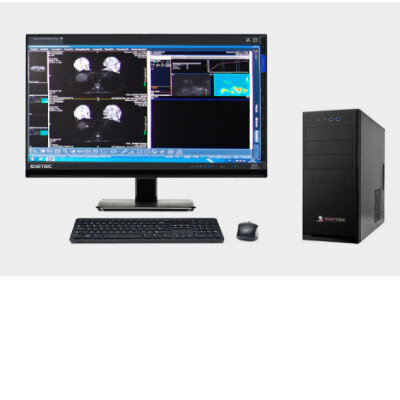Ultrasound-Based 3D Printing Technology Could Enable Surgery without Cutting Open Patient
|
By MedImaging International staff writers Posted on 12 Dec 2023 |

The utilization of 3D-printing tools is expanding rapidly. From developing medical device prototypes and flexible electronics to engineering tissues for wound healing, the applications are diverse. Traditional 3D printing methods often involve slow, point-by-point building of the object on a robust printing platform. Over the past several years, researchers have made advances with photo-sensitive inks that quickly solidify when exposed to light, enhancing printing speed and quality. However, this method is limited by the need for transparent inks and is less effective for biomedical applications due to light's limited tissue penetration.
Now, engineers at Duke University (Durham, NC, USA) and Harvard Medical School (Boston, MA, USA) have made a significant leap forward by developing a biocompatible ink that solidifies into various 3D structures upon exposure to ultrasound waves. This new technique termed deep-penetrating acoustic volumetric printing (DVAP), enables the creation of biomedical structures deep within tissues, suitable for applications such as bone healing or heart valve repair. DVAP utilizes a specialized "sono-ink," comprising hydrogels, microparticles, and molecules designed to react specifically to ultrasound waves. When this sono-ink is introduced into the target area, an ultrasound printing probe emits focused sound waves that solidify the ink into detailed structures. These structures can vary significantly, from bone-like hexagonal scaffolds to hydrogel bubbles for organ application. The sono-ink's composition is adaptable, allowing for varying durability, degradability, or even color in the final product.
The team demonstrated DVAP's potential through three proof-of-concept experiments. In the first test, they successfully sealed a section of a goat’s heart, simulating a procedure for treating nonvalvular atrial fibrillation, which typically requires invasive surgery. The sono-ink was delivered to a goat heart’s left atrial appendage using a catheter in a printing chamber. The ultrasound probe then emitted waves through 12 mm of tissue, solidifying the ink without harming adjacent tissues, resulting in a flexible material capable of enduring heart-like movements. In a second experiment, they explored DVAP's capability for tissue reconstruction and regeneration. They created a bone defect in a chicken leg and injected the sono-ink, solidifying it through layers of skin and muscle tissue. The formed material seamlessly integrated with the bone, showing no adverse effects on nearby tissues.
Lastly, the team demonstrated DVAP's potential in therapeutic drug delivery. They infused a common chemotherapy drug into the sono-ink and delivered it to liver tissue samples. The ultrasound probe then solidified the ink into hydrogels, which gradually released the chemotherapy, diffusing it into the liver tissue. This groundbreaking approach by Duke and Harvard researchers demonstrates DVAP's vast potential in biomedical applications, offering a less invasive and more versatile alternative to traditional treatment methods.
“Because we can print through tissue, it allows for a lot of potential applications in surgery and therapy that traditionally involve very invasive and disruptive methods,” said Junjie Yao, associate professor of biomedical engineering at Duke. “This work opens up an exciting new avenue in the 3D printing world, and we’re excited to explore the potential of this tool together.”
Related Links:
Duke University
Harvard Medical School
Latest Ultrasound News
- Deep Learning Advances Super-Resolution Ultrasound Imaging
- Novel Ultrasound-Launched Targeted Nanoparticle Eliminates Biofilm and Bacterial Infection
- AI-Guided Ultrasound System Enables Rapid Assessments of DVT
- Focused Ultrasound Technique Gets Quality Assurance Protocol
- AI-Guided Handheld Ultrasound System Helps Capture Diagnostic-Quality Cardiac Images
- Non-Invasive Ultrasound Imaging Device Diagnoses Risk of Chronic Kidney Disease
- Wearable Ultrasound Platform Paves Way for 24/7 Blood Pressure Monitoring On the Wrist
- Diagnostic Ultrasound Enhancing Agent to Improve Image Quality in Pediatric Heart Patients
- AI Detects COVID-19 in Lung Ultrasound Images
- New Ultrasound Technology to Revolutionize Respiratory Disease Diagnoses
- Dynamic Contrast-Enhanced Ultrasound Highly Useful For Interventions
- Ultrasensitive Broadband Transparent Ultrasound Transducer Enhances Medical Diagnosis
- Artificial Intelligence Detects Heart Defects in Newborns from Ultrasound Images
- Ultrasound Imaging Technology Allows Doctors to Watch Spinal Cord Activity during Surgery

- Shape-Shifting Ultrasound Stickers Detect Post-Surgical Complications
- Non-Invasive Ultrasound Technique Helps Identify Life-Changing Complications after Neck Surgery
Channels
Radiography
view channel
Novel Breast Imaging System Proves As Effective As Mammography
Breast cancer remains the most frequently diagnosed cancer among women. It is projected that one in eight women will be diagnosed with breast cancer during her lifetime, and one in 42 women who turn 50... Read more
AI Assistance Improves Breast-Cancer Screening by Reducing False Positives
Radiologists typically detect one case of cancer for every 200 mammograms reviewed. However, these evaluations often result in false positives, leading to unnecessary patient recalls for additional testing,... Read moreMRI
view channel
PET/MRI Improves Diagnostic Accuracy for Prostate Cancer Patients
The Prostate Imaging Reporting and Data System (PI-RADS) is a five-point scale to assess potential prostate cancer in MR images. PI-RADS category 3 which offers an unclear suggestion of clinically significant... Read more
Next Generation MR-Guided Focused Ultrasound Ushers In Future of Incisionless Neurosurgery
Essential tremor, often called familial, idiopathic, or benign tremor, leads to uncontrollable shaking that significantly affects a person’s life. When traditional medications do not alleviate symptoms,... Read more
Two-Part MRI Scan Detects Prostate Cancer More Quickly without Compromising Diagnostic Quality
Prostate cancer ranks as the most prevalent cancer among men. Over the last decade, the introduction of MRI scans has significantly transformed the diagnosis process, marking the most substantial advancement... Read moreUltrasound
view channel
Deep Learning Advances Super-Resolution Ultrasound Imaging
Ultrasound localization microscopy (ULM) is an advanced imaging technique that offers high-resolution visualization of microvascular structures. It employs microbubbles, FDA-approved contrast agents, injected... Read more
Novel Ultrasound-Launched Targeted Nanoparticle Eliminates Biofilm and Bacterial Infection
Biofilms, formed by bacteria aggregating into dense communities for protection against harsh environmental conditions, are a significant contributor to various infectious diseases. Biofilms frequently... Read moreNuclear Medicine
view channel
New SPECT/CT Technique Could Change Imaging Practices and Increase Patient Access
The development of lead-212 (212Pb)-PSMA–based targeted alpha therapy (TAT) is garnering significant interest in treating patients with metastatic castration-resistant prostate cancer. The imaging of 212Pb,... Read moreNew Radiotheranostic System Detects and Treats Ovarian Cancer Noninvasively
Ovarian cancer is the most lethal gynecological cancer, with less than a 30% five-year survival rate for those diagnosed in late stages. Despite surgery and platinum-based chemotherapy being the standard... Read more
AI System Automatically and Reliably Detects Cardiac Amyloidosis Using Scintigraphy Imaging
Cardiac amyloidosis, a condition characterized by the buildup of abnormal protein deposits (amyloids) in the heart muscle, severely affects heart function and can lead to heart failure or death without... Read moreGeneral/Advanced Imaging
view channel
New AI Method Captures Uncertainty in Medical Images
In the field of biomedicine, segmentation is the process of annotating pixels from an important structure in medical images, such as organs or cells. Artificial Intelligence (AI) models are utilized to... Read more.jpg)
CT Coronary Angiography Reduces Need for Invasive Tests to Diagnose Coronary Artery Disease
Coronary artery disease (CAD), one of the leading causes of death worldwide, involves the narrowing of coronary arteries due to atherosclerosis, resulting in insufficient blood flow to the heart muscle.... Read more
Novel Blood Test Could Reduce Need for PET Imaging of Patients with Alzheimer’s
Alzheimer's disease (AD), a condition marked by cognitive decline and the presence of beta-amyloid (Aβ) plaques and neurofibrillary tangles in the brain, poses diagnostic challenges. Amyloid positron emission... Read more.jpg)
CT-Based Deep Learning Algorithm Accurately Differentiates Benign From Malignant Vertebral Fractures
The rise in the aging population is expected to result in a corresponding increase in the prevalence of vertebral fractures which can cause back pain or neurologic compromise, leading to impaired function... Read moreImaging IT
view channel
New Google Cloud Medical Imaging Suite Makes Imaging Healthcare Data More Accessible
Medical imaging is a critical tool used to diagnose patients, and there are billions of medical images scanned globally each year. Imaging data accounts for about 90% of all healthcare data1 and, until... Read more
Global AI in Medical Diagnostics Market to Be Driven by Demand for Image Recognition in Radiology
The global artificial intelligence (AI) in medical diagnostics market is expanding with early disease detection being one of its key applications and image recognition becoming a compelling consumer proposition... Read moreIndustry News
view channel
Bayer and Google Partner on New AI Product for Radiologists
Medical imaging data comprises around 90% of all healthcare data, and it is a highly complex and rich clinical data modality and serves as a vital tool for diagnosing patients. Each year, billions of medical... Read more





















